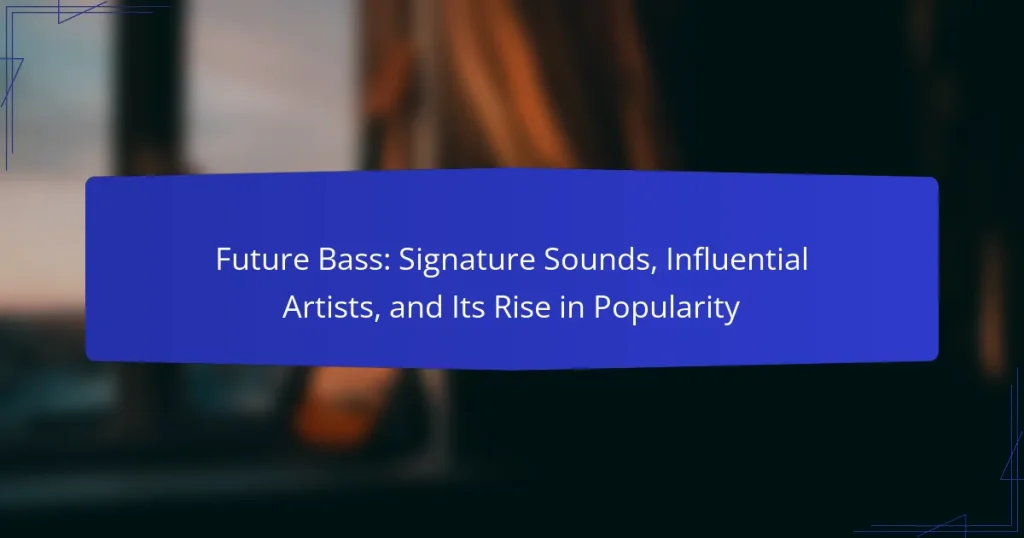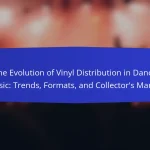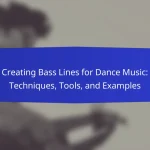Future Bass is a genre of electronic music known for its lush synths, vibrant melodies, and heavy bass lines, emerging prominently in the early 2010s through platforms like SoundCloud. Influential artists such as Flume and Marshmello have played a significant role in popularizing this genre, which blends elements from trap, pop, house, and R&B, appealing to a diverse audience. The genre often features emotional themes, contributing to its integration into mainstream music and the rise of electronic music festivals. Future Bass is expected to continue evolving, with increased collaborations between its artists and mainstream musicians, driven by advancements in music production technology and the accessibility provided by streaming platforms.
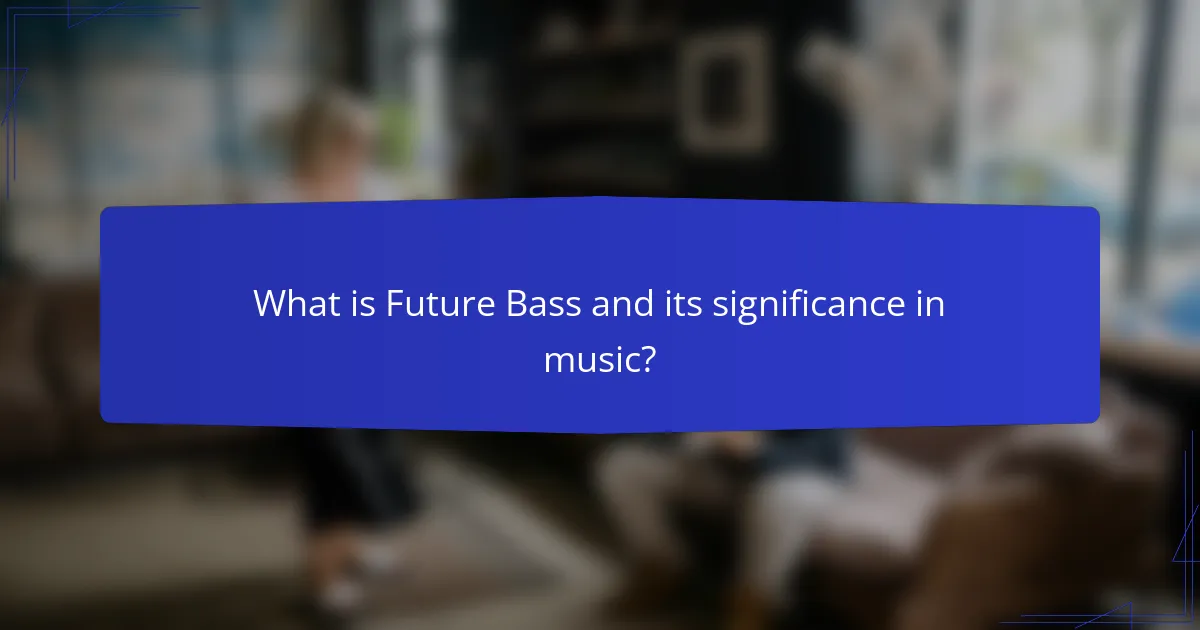
What is Future Bass and its significance in music?
Future Bass is a genre of electronic music characterized by its use of lush synths, vibrant melodies, and heavy bass lines. It emerged in the early 2010s, gaining prominence through platforms like SoundCloud. Artists such as Flume and Marshmello have significantly influenced its popularity. Future Bass blends elements from various genres, including trap and pop. This versatility allows it to appeal to a broad audience. The genre often features emotional and uplifting themes, making it suitable for mainstream music. Its significance lies in shaping modern electronic music trends and influencing pop culture. Future Bass has also contributed to the rise of electronic music festivals and the expansion of artist collaborations.
How did Future Bass originate and evolve over time?
Future Bass originated in the early 2010s as a subgenre of electronic dance music. It emerged from the fusion of various styles, including trap, dubstep, and house music. Artists like Flume and Cashmere Cat played pivotal roles in defining its sound. The genre is characterized by its melodic elements, heavy use of synthesizers, and unique basslines. Over time, Future Bass evolved to incorporate a wider range of influences, including pop and R&B. This evolution led to collaborations with mainstream artists, increasing its popularity. By the mid-2010s, Future Bass became a dominant force in music festivals and radio playlists. Its distinctive sound continues to influence new artists and genres today.
What are the key influences that shaped Future Bass?
Future Bass is shaped by various key influences. Its roots can be traced to genres like Trap, Dubstep, and House. The sound design often incorporates lush synths, vocal chops, and heavy basslines. Influential artists include Flume, who popularized the genre with his unique style. Other notable figures are Marshmello and San Holo, who also contributed to its evolution. The genre gained traction through platforms like SoundCloud and YouTube. Collaboration with pop artists further expanded its reach and appeal. Overall, Future Bass reflects a blend of electronic music influences and innovative production techniques.
How does Future Bass differentiate itself from other electronic genres?
Future Bass differentiates itself from other electronic genres through its unique sound design and emotional depth. It prominently features lush synths, vibrant chords, and heavy use of sidechain compression. The genre often incorporates pitched vocal chops that create a melodic and airy atmosphere. Unlike genres such as Dubstep or House, Future Bass tends to focus on uplifting and euphoric feelings. Additionally, it frequently employs a 140 BPM tempo, which is distinct from the faster pace of Trap or the steadiness of Techno. Artists like Flume and Marshmello have popularized this style, contributing to its mainstream appeal. Their tracks often blend elements from various genres while maintaining a signature Future Bass sound. This fusion of styles is a hallmark of the genre’s identity.
What are the signature sounds of Future Bass?
The signature sounds of Future Bass include lush synths, heavy basslines, and vibrant chord progressions. These elements create a rich and atmospheric sound. Vocal chops are also prominent, often manipulated to add texture. Future Bass typically features syncopated rhythms and a strong emphasis on the drop. The genre often employs sidechain compression for a pumping effect. Additionally, sound design plays a crucial role, with unique synth patches and samples. Artists like Flume and Marshmello have popularized these sounds. Their tracks often showcase the genre’s signature characteristics.
What instruments and technology are commonly used in Future Bass production?
Future Bass production commonly utilizes synthesizers, drum machines, and digital audio workstations (DAWs). Popular synthesizers include Serum, Massive, and Sylenth1. These synths are known for their rich sound design capabilities. Drum machines like the Roland TR-808 are frequently used for creating unique drum patterns. DAWs such as Ableton Live and FL Studio are essential for arranging and mixing tracks. Additionally, plugins for effects and sound manipulation enhance the production quality. The integration of these instruments and technologies contributes to the genre’s distinctive sound.
How do sound design techniques contribute to the Future Bass aesthetic?
Sound design techniques are essential to the Future Bass aesthetic. They create lush, emotive soundscapes that define the genre. Techniques such as sidechain compression produce a pumping effect, enhancing the rhythmic drive. Layering synths adds depth and richness to the overall sound. The use of pitch modulation creates unique melodic elements that stand out. Sampling vocal chops introduces a human touch, making tracks relatable. Effects like reverb and delay contribute to the atmospheric quality of Future Bass. These techniques collectively shape its signature sound, distinguishing it from other electronic genres.
Who are the influential artists in the Future Bass genre?
Flume, ODESZA, and Marshmello are influential artists in the Future Bass genre. Flume is known for his innovative sound design and production techniques. His self-titled debut album won a Grammy Award. ODESZA gained recognition with their lush soundscapes and live performances. Their album “A Moment Apart” reached number three on the Billboard 200 chart. Marshmello is famous for his catchy melodies and collaborations with various artists. He has multiple chart-topping hits in the genre. These artists have significantly shaped the Future Bass scene and contributed to its popularity.
Which artists are considered pioneers of Future Bass?
Artists considered pioneers of Future Bass include Flume, Cashmere Cat, and Lido. Flume’s debut album, released in 2012, showcased innovative sound design and production techniques. Cashmere Cat gained recognition for blending trap elements with Future Bass. Lido’s work in 2014 introduced a unique vocal manipulation style that influenced the genre. These artists played significant roles in shaping Future Bass’s signature sound and expanding its audience. Their contributions helped establish Future Bass as a prominent genre in electronic music.
How have these artists shaped the direction of Future Bass music?
Artists have significantly shaped the direction of Future Bass music through their innovative sound design and unique production techniques. They have introduced lush synths, vibrant chords, and intricate beats that define the genre. Pioneers like Flume and Marshmello have popularized Future Bass by blending elements from various genres, including trap and pop. Their tracks often feature emotive melodies and vocal chops that resonate with listeners. Collaborations with mainstream artists have further elevated the genre’s visibility. The success of tracks such as “Never Be Like You” by Flume showcases the commercial appeal of Future Bass. Additionally, artists have utilized platforms like SoundCloud to share their work, contributing to the genre’s grassroots growth. This accessibility has allowed emerging producers to influence the soundscape of Future Bass. Overall, these artists have been instrumental in evolving Future Bass into a mainstream genre recognized for its emotional depth and sonic diversity.
What factors contributed to the rise in popularity of Future Bass?
The rise in popularity of Future Bass is attributed to its distinctive sound and accessibility. Future Bass incorporates lush synths, vibrant melodies, and heavy bass drops. These elements appeal to a wide audience, including electronic music fans and casual listeners. The genre gained traction through platforms like SoundCloud and YouTube. Many influential artists, such as Flume and Marshmello, played a significant role in popularizing Future Bass. Their tracks often topped charts and received millions of streams. Collaborations with mainstream pop artists further expanded its reach. The vibrant visuals associated with Future Bass music videos also contributed to its appeal. Overall, the combination of unique sound, influential artists, and accessible platforms fueled its rise in popularity.
How has social media impacted the spread of Future Bass?
Social media has significantly accelerated the spread of Future Bass. Platforms like SoundCloud and Instagram have enabled artists to share their music directly with listeners. This direct access allows for rapid dissemination of new tracks and remixes. Viral trends often emerge through user-generated content, driving more engagement. Additionally, social media facilitates collaboration among artists across different regions. The genre’s visual aesthetic is easily shared through platforms, enhancing its appeal. Hashtags related to Future Bass help in categorizing and promoting content. As a result, the genre has gained a global audience faster than traditional music distribution methods.
What role do music festivals and events play in promoting Future Bass?
Music festivals and events play a crucial role in promoting Future Bass. They provide a platform for artists to showcase their work to large audiences. Festivals often feature multiple stages, allowing various Future Bass artists to perform simultaneously. This exposure helps to introduce the genre to new listeners. Events like Coachella and Electric Daisy Carnival have included Future Bass artists, increasing their visibility. The energetic atmosphere of live performances enhances audience engagement with the music. Additionally, festivals create a sense of community among fans of the genre. Social media buzz generated during these events further amplifies Future Bass’s reach. Overall, music festivals significantly contribute to the growth and popularity of Future Bass music.
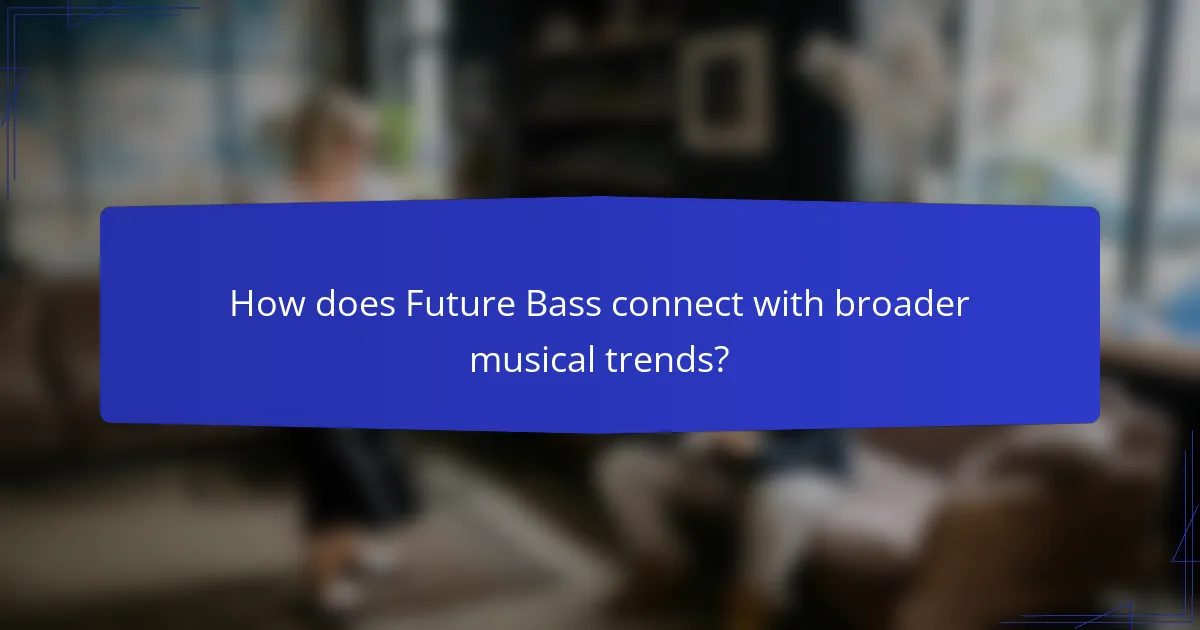
How does Future Bass connect with broader musical trends?
Future Bass connects with broader musical trends through its fusion of electronic and pop elements. This genre incorporates influences from trap, house, and R&B, creating a versatile sound. The use of lush chords and melodic drops aligns it with contemporary pop music. Artists like Flume and Marshmello have popularized Future Bass, bridging gaps between genres. The rise of streaming platforms has facilitated its integration into mainstream music. Collaborations with pop artists have further solidified its presence. Future Bass reflects evolving listener preferences for catchy and emotional soundscapes. Its rhythmic diversity resonates with current trends in electronic dance music.
What collaborations are significant within the Future Bass community?
Significant collaborations within the Future Bass community include works by prominent artists like Flume and Kai. Their track “Never Be Like You” achieved critical acclaim and commercial success. Another notable collaboration is between ODESZA and Leon Bridges on “Across the Room,” which showcases the genre’s melodic depth. Additionally, the partnership of Marshmello and Bastille on “Happier” demonstrates the crossover appeal of Future Bass. These collaborations highlight the genre’s ability to blend electronic music with diverse vocal talents. They have contributed to the genre’s growth and popularity in mainstream music.
How does Future Bass intersect with other genres?
Future Bass intersects with several genres, including trap, house, and pop. It incorporates elements from trap, such as heavy bass and syncopated rhythms. The genre also draws from house music, particularly in its use of uplifting melodies and build-ups. Future Bass often features vocal chops, a characteristic borrowed from pop music. Artists like Flume and Marshmello blend these influences seamlessly in their tracks. This fusion creates a distinctive sound that appeals to a wide audience. The genre’s adaptability allows for continuous evolution, integrating new styles and techniques.
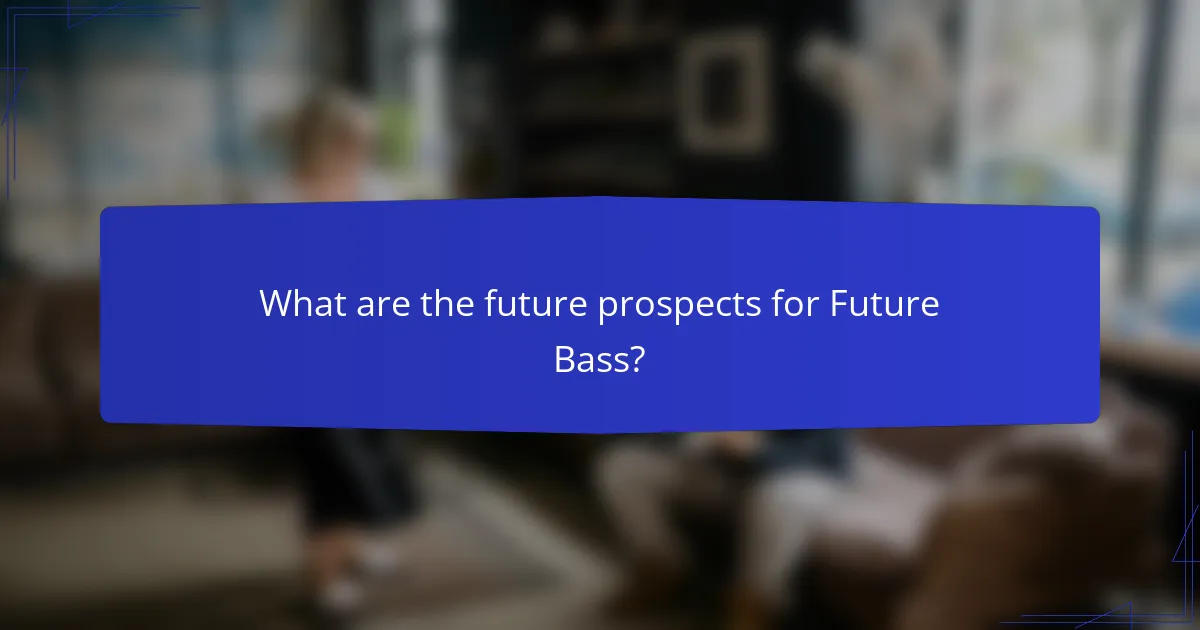
What are the future prospects for Future Bass?
Future Bass is expected to evolve and maintain its relevance in the electronic music scene. The genre has already influenced mainstream pop and hip-hop. Collaborations between Future Bass artists and popular musicians are likely to increase. This trend can attract new listeners and expand its audience. Additionally, advancements in music production technology will enable artists to innovate within the genre. The rise of streaming platforms has also facilitated easier access to Future Bass music. These platforms can help emerging artists gain visibility. Overall, Future Bass shows strong potential for growth and adaptation in the music industry.
How might Future Bass continue to evolve in the coming years?
Future Bass may evolve by incorporating more diverse musical influences. Artists are likely to blend genres such as hip-hop, R&B, and pop into Future Bass. This fusion can lead to innovative soundscapes and new rhythmic patterns. Additionally, advancements in technology may allow for more intricate sound design. Producers might utilize AI and machine learning to create unique samples and effects. Collaborations with mainstream artists could further popularize the genre. As the audience grows, Future Bass may also see a shift towards more lyrical content. This evolution reflects broader trends in electronic music and listener preferences.
What emerging artists are likely to influence the future of Future Bass?
Emerging artists likely to influence the future of Future Bass include Flume, San Holo, and Mura Masa. Flume has reshaped the genre with his innovative sound design and unique production techniques. San Holo is known for blending Future Bass with guitar elements, creating a fresh sound. Mura Masa combines various genres, pushing the boundaries of Future Bass with eclectic influences. These artists are gaining significant recognition and have amassed large followings. Their distinct styles and creative approaches are setting new trends in the genre. Their contributions are expected to shape the evolution of Future Bass in the coming years.
How can listeners support the Future Bass scene?
Listeners can support the Future Bass scene by purchasing music and merchandise from artists. This directly contributes to the artists’ income. Engaging with artists on social media also helps increase their visibility. Sharing tracks and playlists on platforms like Spotify boosts streams. Attending live shows and festivals supports the local scene and promotes community. Joining online forums or groups dedicated to Future Bass fosters discussion and discovery. Lastly, streaming music on legal platforms ensures artists receive fair compensation. These actions collectively strengthen the Future Bass ecosystem.
What are some tips for getting into Future Bass production?
Start by learning the fundamentals of music production software. Programs like Ableton Live and FL Studio are popular in Future Bass. Experiment with sound design using synthesizers. Focus on creating lush chords and vibrant melodies. Layer different sounds to achieve a fuller texture. Incorporate unique vocal chops for a signature sound. Study the work of influential Future Bass artists like Flume and San Holo. Analyze their tracks to understand structure and arrangement. Practice regularly to improve your skills and develop your own style.
What software and tools are recommended for beginners in Future Bass?
FL Studio is highly recommended for beginners in Future Bass. It offers an intuitive interface and a wide range of features. Ableton Live is another great option, known for its real-time performance capabilities. Logic Pro X is favored for its robust sound library and MIDI capabilities. Serum is a popular synthesizer for creating unique sounds. Additionally, Splice provides access to samples and loops that can enhance production. These tools are widely used in the Future Bass community, ensuring a solid foundation for new producers.
How can aspiring producers develop their unique sound within Future Bass?
Aspiring producers can develop their unique sound within Future Bass by experimenting with sound design. Utilizing synthesizers and sampling techniques allows for originality. Producers should explore various chord progressions and melodies to create distinct tracks. Layering sounds effectively can enhance the richness of their music. Incorporating unique vocal samples or effects can further differentiate their style. Collaborating with other artists can provide new perspectives and ideas. Analyzing influential Future Bass tracks helps in understanding successful elements. Continuous practice and feedback are essential for refining their sound.
Future Bass is an electronic music genre known for its lush synths, vibrant melodies, and heavy bass lines, emerging in the early 2010s through platforms like SoundCloud. The article covers its origins, key influences, and signature sounds, highlighting how artists like Flume and Marshmello have shaped its popularity and evolution. It also explores the role of social media and music festivals in promoting Future Bass, as well as the genre’s intersection with other styles and its future prospects. Additionally, the article provides insights into production techniques, tools for aspiring producers, and tips for developing a unique sound within the genre.
